Cucumber Kimchi Pickles
Cucumber kimchi (Oi Kimchi, 오이 김치) is a popular summer kimchi in Korea. Many families have their versions of cucumber kimchi, each delicious in unique ways.
Cucumber kimchi is a fun ferment to make, and if you’d like to make authentic Korean cucumber kimchi, I suggest this recipe from My Korean Kitchen. You can also check out her blog to learn more about cucumber kimchi.
The flavors of cucumber kimchi inspired me, and I always try to keep my recipes original enough to call them my own. So, I made these cucumber kimchi inspired spicy garlic pickles, and I included spices and seasoning similar to those found in kimchi.
Fermented Spicy Garlic Pickles
When we decided to use our spiralizer to cut the cucumbers, I was a little worried about how the texture would come out… but these turned out wonderfully crunchy and perfect for sandwiches. No matter the cut, the key to a crunchy pickle is a proper salt concentration.
Here are all the ingredients you need to make these delicious pickles:
- 400 grams of pickling cucumbers, washed
- 5 garlic cloves, sliced
- 2 tablespoons dried onion flakes
- 1 tablespoon gochugaru red pepper flakes
- 2 tablespoons ginger, fresh
- 400 grams water
- 28 grams of sea salt
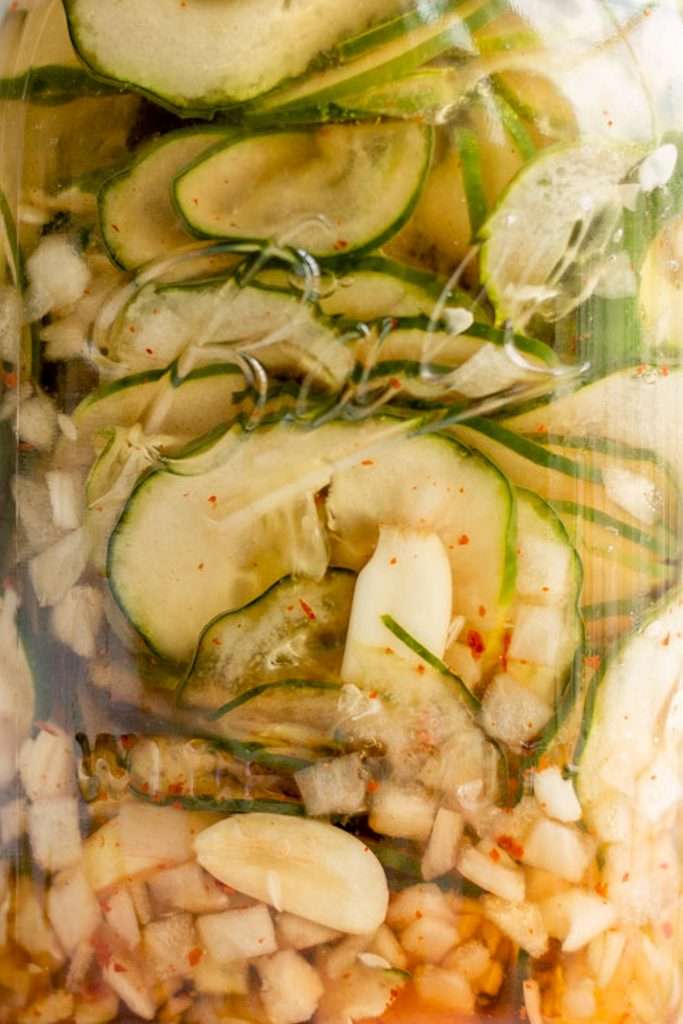
How to Choose a Good Cucumber for Cucumber Kimchi Pickles
I suggest using two types of cucumbers to ferment your pickles. The first is English cucumbers, the long cucumbers commonly sold tightly wrapped in plastic. The second is pickling the shorter, bumpy, lighter green cucumbers.
Do not use slicing cucumbers for fermentation. These are very smooth, dark green cucumbers and are usually fat and long. Most slicing cucumbers will turn into a soggy mess through the fermentation process. Slicing cucumbers are also normally wax-coated, which disrupts the fermentation process.
Here’s my checklist for choosing good cucumbers:
- Density: The cucumber should feel heavy, like it is hydrated and has turgor pressure. It should not feel hollow, like yellow squash, if you tap your finger against it.
- “Check for surface mold: Look for indentions and soft spots in the cucumbers; you do not want to buy a squishy cucumber. Cucumbers close to molding will have dark, small, circular indentions or black” pocks” on the surface. “Check for surface mold: Look for indentions and soft spots in the cucumbers; you do not want to buy a squishy cucumber. Cucumbers close to molding will have dark, small, circular indentions or black “pocks” on the surface.
- Small is Better: The bigger the diameter of the cucumber, the soggier your pickles will be. If buying English cucumbers, look for one with a smaller diameter. If you are buying pickling cucumbers, go for the smaller dainty cucumbers.
- Color: Pickling cucumbers should be predominately green with streaks of yellowish-green. English cucumbers should be a solid medium green color.
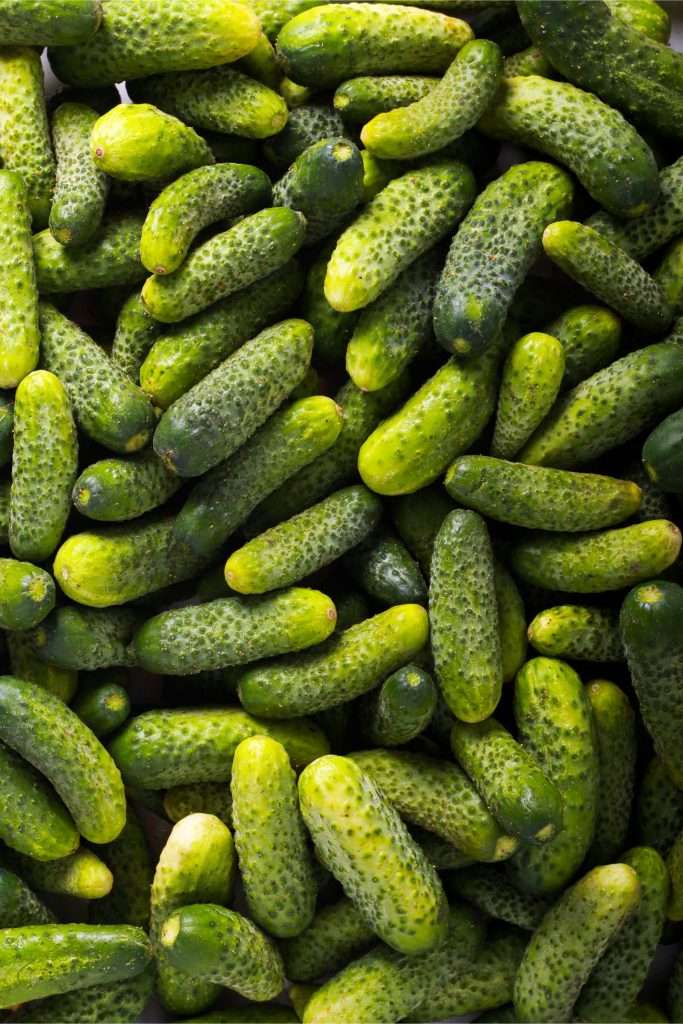
Soggy Pickles?
Cucumbers are subject to sogginess when fermented. Since the inside of a cucumber is mostly water, when cucumbers are fermented, Leuconostoc bacteria in stage two of the fermentation can break down the cucumber structure in excess, causing soggy pickles.
To help prevent sogginess, start with cold cucumbers. For tannins, you can also add bay leaves, sencha green tea, and grape leaves.
You can also try adding calcium chloride salt to pickles, which keeps things crunchy. (Some sources of calcium chloride are natural from limestone… and some are chemically produced. I suggest researching this salt and deciding if you’d like it in your food).
The most immediate fix for soggy pickles is to use a 3 to 4% total salt concentration. All of my pickle recipes call for enough salt to avoid soggy pickles.
The slicing impacts how the pickles hold up during fermentation too. You can try a ripple cut using a mandolin blade or fermenting pickle spears instead of pickle chips.
Also, you should always remove the ends of cucumbers and not include the ends in the fermentation. The blossom end of cucumbers contains enzymes that can also soften the cucumbers.

Making Cucumber Kimchi Inspired Spicy Garlic Pickles
To master fermentation, you’ll need to use weight measurements for your fermentation ingredients, which means you need a kitchen scale.
To select the best probiotic bacteria (the beneficial ones) in your ferments, you must weigh salt to create a specific salt concentration. Weighing salt is the only way to make a salt concentration that will select only probiotic microbes to thrive. You can read more about why you must weigh your salt here.
Supplies You Need to Start Making Fermented Spicy Garlic Pickle Spirals
- 32-ounce Wide Mouth Mason Jar
- Fermentation Weight
- Standard Metal Mason Jar Lid (this can rust in the presence of salt)
- OR Rust-Free Plastic Lid
- or you can use a Weck Jar (without the gasket; only use the clips to secure the lid)
- Sea Salt
- Scale
- Mixing Bowl

Care Guide for Cucumber Kimchi Inspired Pickles
During the first few days of fermentation: Microbes make a lot of carbon dioxide and bubbles. Sometimes jars will become packed with liquid, and this liquid can seep out.
When this happens, remove the lid and tamper everything back down using a gloved hand, tamper, or spoon. Make sure everything is still submerged under the fermentation weight below the brine. You can also rinse the lid clean daily.
What Temperature Should I Keep the Pickles at?
Keep your fermenting pickle spirals at a temperature between 70-80 degrees F. Keep out of direct sunlight. When fermentation is complete at two weeks, please place it in the refrigerator.
How Long Should I Ferment Pickles For?
After 2-4 weeks, remove the fermentation weight, smell, and taste test. Your fermented pickles should smell pleasantly sour and taste tart and crisp.
Always Trust your sense of smell: Fermented cucumbers should smell pleasantly sour and more smooth than a vinegar pickle. Never eat anything that smells repulsive.
Taste test at two weeks: If you prefer the pickles to be more tart and sour, let them ferment for another week.
Do I Need to Refrigerate My Cucumber Kimchi Pickles?
After fermenting for at least two weeks, place a regular mason jar lid on the jar and refrigerate. Consume within six months for full probiotic benefits.
Pickle Recipe Fermentation Timeline
We tracked our pickle spirals throughout the fermentation process. By checking the progress of microbial stages under the microscope, we have provided you with this handy timeline!
24 – 72 hours: All contents in the jar should be submerged beneath the brine. At this time, Gram-negative bacteria and possible pathogens are still present.
72 hours – 7 days: After 72 hours, you should start to see lots of bubbles being produced. This is the stage in which you will burp the jar. This is when the ferment enters stage two of vegetable fermentation. Leuconostoc bacteria begin to thrive and produce a lot of carbon dioxide, and gram negative organisms die off.
7 – 12 days: The bubbles in the brine will decrease as the ferment leaves stage two and enters stage three. The mixture will become cloudy and develop a pleasantly sour and garlic smell. Lactobacillus species are most abundant during this period.
12 – 14 days: Lactobacillus comprise most or all microbial populations. They produce copious amounts of lactic ac, making the ferment smell even more pleasantly sour. This is the time in which the vegetable mixture becomes preserved. This is when you want to smell and taste test.
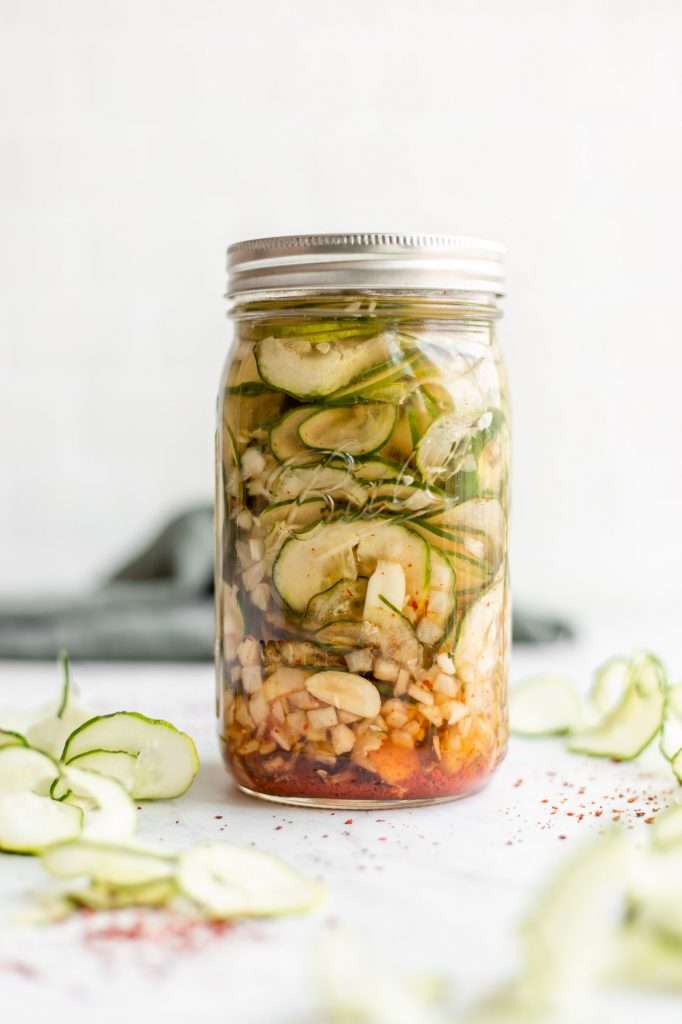

Cucumber Kimchi Inspired Spicy Garlic Pickles
The spicy, umami flavors of cucumber kimchi inspire these spicy garlic pickles! These pickles only take a few minutes to prepare and 14 days of fermentation time. Put these spiral-cut pickles on any sandwich or burger this summer and enjoy the salty, sour flavors of wild fermented spicy garlic pickle spirals.
- Prep: 15 minutes
- Total Time: 336 hours 15 minutes
Ingredients
- 450 grams pickling cucumbers, washed & spiral cut
- 5 garlic cloves, sliced
- 2 tablespoons dried onion flakes
- 1 tablespoon gochugaru red pepper flakes
- 2 tablespoons ginger, fresh & sliced
- 350 grams water
- 28 grams sea salt
Instructions
- Wash all of your fermentation equipment (jar, weight, and lid)
- Wash your pickling cucumbers in cool water. Using a spiralizer, spiral cut the cucumbers. (alternatively, you can cut the pickles however you want.)
- Place your kitchen scale on the counter. Turn it on and set it to weigh in grams.
- Place a mixing bowl on your kitchen scale and tare/zero the scale.
- Add the spiral cut cucumbers into the bowl on your scale until the scale reads 450 grams.
- Remove the bowl from your scale and set aside. Place your empty, clean mason jar on the scale, and tare/zero the scale. Make sure your scale is still set to grams and add 350 grams of filtered water to your mason jar.
- Add the cucumbers from your bowl, into the mason jar with water.
- Place a small bowl on your scale and tare/zero the scale. Weigh out 28 grams of salt. Then add the salt to the jar of cucumbers and water.
- Add all the remaining ingredients.
- Place your standard mason jar lid on the jar, and secure. Shake the jar vigorously for 2 minutes.
- Remove the mason jar lid. Place your fermentation weight in the jar making sure to submerge the cucumber pieces and weight fully in the liquid.
- Secure the mason jar lid and allow to ferment for 2 weeks before storing in the fridge.
Notes
This recipe at 1x works well with a 32-ounce mason jar.
The recipe amounts listed here fill the jar. You may have some spillover when adding a fermentation weight and during the bubbly stage of fermentation. place the jar in a bowl to catch spills and use a plastic lid to avoid rust.
Taring/zeroing the scale with a container on it subtracts the weight of the container, allowing you to weigh only what is added to the container. After taring/zeroing the scale, the scale should read 0.0 with the container on it.















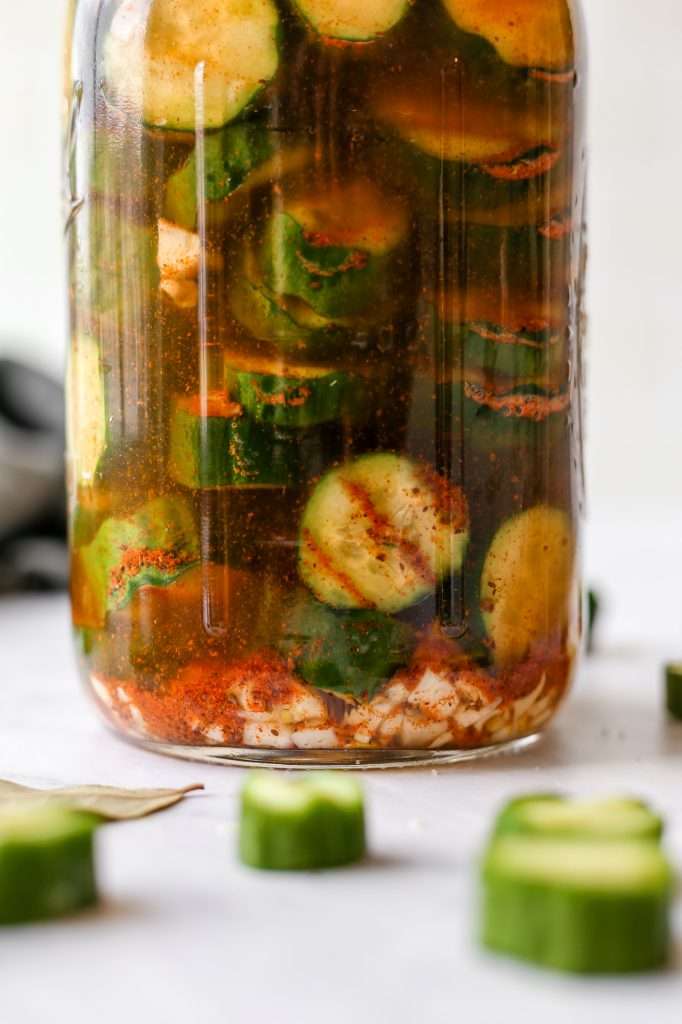
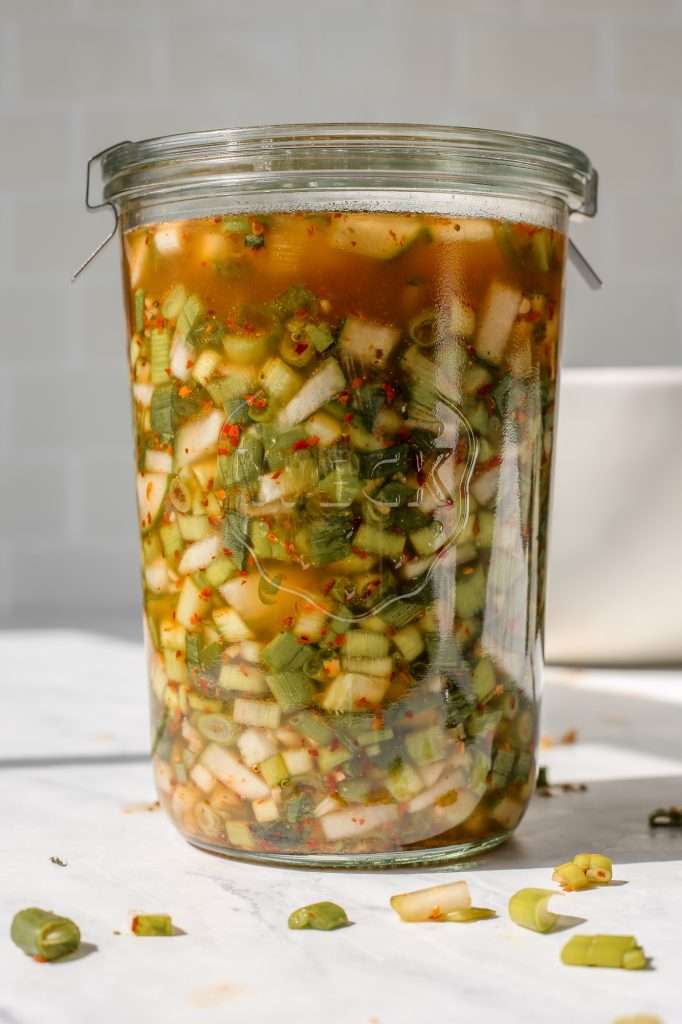


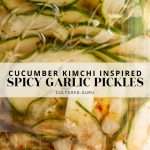
I made these using small cucumbers at my local co-op. They weren’t labelled pickling, so don’t know if there’s a difference. Anyway, they were fantastic! I think this is my favorite brine ever. When we finished up the jar, they were gone very quickly I might add, I chopped up some carrots, put them in the jar with the leftover brine, and we ate all the carrots within a couple of days.
What other vegetables do you think I could ferment using this recipe?
Thanks!
Amazing, tasty and easy!! Having an abundance of pickling cucumbers from my garden; I wanted to try something different from the usual pickles. Don’t get me wrong, the pickling recipe of yours is fantastic (your pickling spice is amazing). I made 3 quarts of this on June25th; took them out of the pantry this morning to try and I was totally blown away!!! Crunchy ,tangy, sour and spicy all in one. I can’t wait to try this on a burger. I’m also thinking about topping some sprouted lentil stew with it. I have fermented before; sometimes successfully but many times not so much. Your recipes are accurate and weighing everything out is worth the time( which isn’t much).If anyone is wondering if fermentation weights are really necessary, a big Absolutely is my answer. They are inexpensive and you won’t be throwing out ruined food.
I am a fan of Kosher salt can I use that instead of Sea Salt and if so do I need to adjust my recipe because the size of the flakes
yep, as long as there are no anti-caking agents in the salt, you can use it.
400gms or 450gms of cukes?
Made these with small whole pickling cucumbers. The spice is perfect, the garlic and ginger are good once fermented too.
Made this this afternoon and have a couple questions! First off, I didn’t have enough pickling cucumbers(just took what I had fresh from the garden). I substituted the rest for fresh onion up to the 450 g and omitted the dried onion in lieu. Do you think that will work? Also I only had gochugaru powder. I put in a full tablespoon before I realized. Will it just be extra spicy?
Thank you! Excited to see how it turns out!